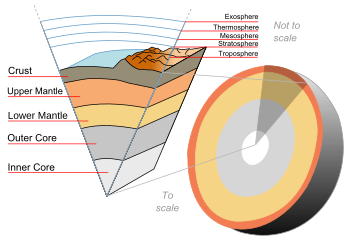Travel to the Earth's center: Difference between revisions
m One word. All the difference in the world. |
No edit summary |
||
| Line 13: | Line 13: | ||
==In science== |
==In science== |
||
Though no scientists have proposed travel to the Earth's center, [[David J. Stevenson]] has suggested sending a probe to the Earth's core. |
Though no scientists have proposed travel to the Earth's center, [[David J. Stevenson]] has suggested sending a probe to the Earth's core. |
||
== Deepest depth achieved == |
|||
So far, the deepest humans have drilled is just over 12 kilometers, in the [[Kola Superdeep Borehole]]. |
|||
==See also== |
==See also== |
||
Revision as of 04:09, 28 January 2008

Though not currently considered scientifically possible, Travel to the Earth's center is a popular theme in science fiction. Some subterranean fiction involves travel to the Earth's center, either finding a Hollow Earth or the Earth's molten core.
Hollow Earth
A "Hollow Earth" theory posits that the planet Earth has a hollow interior and probably a habitable inner surface. At one time, adventure literature made this idea popular. The scientific community dismisses it as pseudoscience - but it remains a popular feature of many fantasy and science fiction worlds, and is an explanation to conspiracy theories.
In the media
Most famous, Jules Verne's 1864 science fiction novel Journey to the Center of the Earth set the stage for travel to the Earth's center. The 2003 film The Core concerns a team that has to drill to the center of the Earth and set off a series of nuclear explosions in order to restart the rotation of Earth's core. It was loosely based on the novel Core.
The movie provided a great deal of consideration on the theoretical sciences and applications involved in sending man to his planet's center. The vehicle used in the movie was a snake-like ship, dubbed Virgil. Built in 3 months, Virgil had a powerful rotating laser drill at its front, a small nuclear reactor for power, an unobtainium shell for the intense heat and pressures, a powerful x-ray camera for viewing outside, and a system of impellers for movement and control. The scientific applications needed for a ship like Virgil are beyond our current capabilities, but we are quickly heading in that direction.
In science
Though no scientists have proposed travel to the Earth's center, David J. Stevenson has suggested sending a probe to the Earth's core.
Deepest depth achieved
So far, the deepest humans have drilled is just over 12 kilometers, in the Kola Superdeep Borehole.
See also
- Structure of the Earth
- Planetary core
- List of science fiction themes
- Drilling through the Earth's crust:
